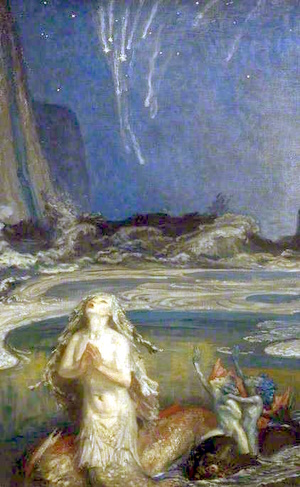
IN the old days Culain, the smith of the gods, was living in the Isle of Mann. It was the time when Conchubar was at the court of the King of Ulster, and had nothing but the sword in his hand. He was a fine handsome young man, and he had made up his mind to make himself a king. So he went one day to the Druid of Clogher to ask him what he had best do.
(Ayns ny shenn laghyn va Culain, gaaue ny jeeghyn, cummal ayns Mannin. Ec y traa shen va Conchubar ec cooyrt Ree Ullee, as cha row red erbee echey agh y cliwe v’ ayns e laue. V’eh ny ghooinney aeg, braew as bwaagh, as va’n aigney echey slane soit er jannoo eh hene ny ree. Myr shen, laa dy row, hie eh dys Druaight Chlogher dy vriaght jeh cre lhisagh eh jannoo).
‘Go thy way,’ said the Druid, ‘to the Isle of Mann. There thou wilt find the great smith Culain. Get him to make thee a sword and a spear and a shield, and with these thou shalt win the kingdom of Ulster.’
(‘Immee royd,’ dooyrt yn Druaight ‘dys Mannin. Ayns shen yiow oo yn gaaue mooar Culain. Cur ersyn jannoo cliwe as shleiy as scape dhyts, as lhieusyn cossynee oo reeriaght Ullee.’)
Conchubar went away, and hired a boat and put out to sea. He landed in Mann and made straight for Culain’s smithy. It was night when he got there, and the red glow of the furnace shone out into the dark. He could hear from inside the smithy the roar of the bellows and the clanging of the hammer on the anvil. When he came near, a great dog, as large as a calf, began to bay and to growl like thunder, and brought his master out.
(Hie Conchubar ersooyl as ren eh failley baatey as hie eh roish er y cheayn. Haink eh er thalloo ayns Mannin as hie eh çhelleeragh lesh keirdee Chulain. Va’n oie ayn tra raink eh, as va bree jiarg yn ‘urnish ry akin soilshean sy dorraghys. Cheayll eh voish çheu sthie y cheirdee garveig ny builg-heidee as clingal yn oard er yn ingan. Tra haink eh faggys da, ghow moddey mooar, cho mooar as lheiy, toshiaght er gullarnee as gyrnal gollrish taarnagh, as hug eh lesh e vainshtyr magh.)